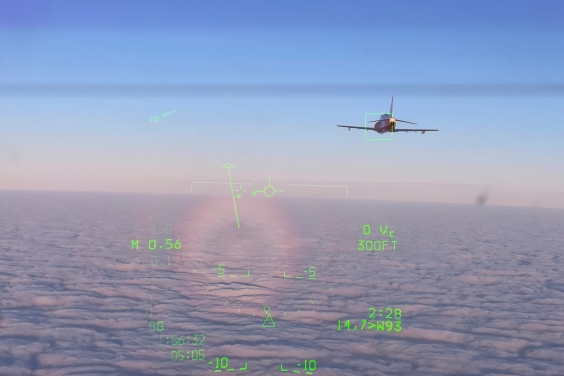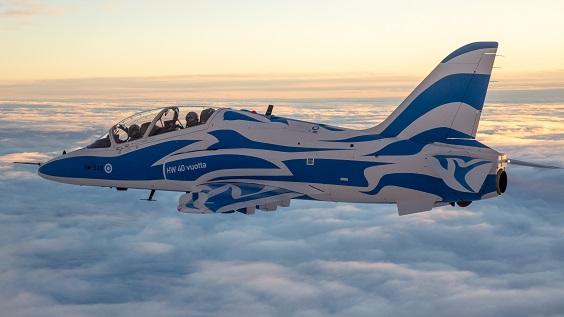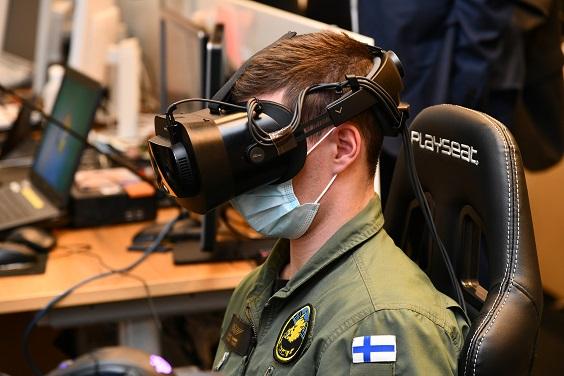Flight training system ready for transition to HX era

The Live, Virtual & Constructive (LVC) training environment enables fighter pilots to train complex air operation scenarios. In the future, most Air Force flight training will be conducted in an environment combining live aircraft, simulators, and computer-generated players controlled by algorithms or artificial intelligence.
The Finnish Air Force and partner companies develop LVC training environments together in Finland. To put it simply, "Live" refers to aircraft flying in the air or actual weapon systems on the ground. "Virtual" usually covers human-operated flight and weapons system simulators on the ground, and "Constructive" means computer-generated players, e.g. aircraft and ground-based air defence assets, that behave as realistically as possible and are controlled by artificial intelligence or pre-programmed algorithms.
Mostly, computer-generated features are used to create a realistic training adversary. All the Live, Virtual & Constructive elements can be networked into the same environment so that they can train either together side-by-side or against each other. The capabilities and behaviour of computer-generated aircraft and weapon systems can be modified in a versatile manner. Thus, based on the learning objectives, it is possible to create enhanced training scenarios and environments that are unfeasible in the real world.
LVC training prepares pilots to transition to multi-role fighters
At the moment, the Air Force utilises the LVC environment e.g. in Hawk flight training. The Hawk Link system, developed by Patria, enables the integration of live Hawk jet trainers in the air and simulators on the ground. A debriefing system registers all the actions and events of an air combat training mission, e.g. position and weapon system information. After the mission, the participants receive detailed feedback based on the registered data.
‒ The flight training is more motivating and the learning results are better when the pilot sitting in a simulator knows that he or she is operating in the same scenario with live aircraft. Furthermore, by adding computer-generated constructive elements, we can create a larger and more complex training environment, explains Lieutenant Colonel Teemu Pöysti, Chief of Air Force Training.
‒ LVC gives us the opportunity to simulate the sensors and systems of a multi-role fighter, e.g. radar and weapon system information, in a jet trainer. This enables us to deepen the training of future fighter pilots by conducting even the early phases of flight training in a more realistic and challenging environment. Consequently, the pilots are more ready when they transition to multi-role fighters, Pöysti says.
Incorporating all the elements and assets of modern air warfare in day-to-day flight training would require a great deal of resources. However, thanks to LVC training, the flight hours can be used as efficiently as possible to achieve the learning objectives.
‒ LVC training helps us to use our flight hours as efficiently as needed and reduce the number of basic aerial target simulation sorties. Due to the flexibility of the LVC environment, we can now train our pilots already with Hawk jet trainers in advanced tactics and techniques that was earlier done with F/A-18 Hornets, says Lieutenant Colonel Lauri Suominen, Commander of Air Force Academy's Fighter Squadron 41.

Future flight training highlights the role of LVC environment
In the future, the role of LVC will increase further in all the phases of flight training. The new multi-role fighters, to be procured through the HX programme, will require a training system utilising the LVC environment fully. In the 2030s, the objective is to conduct most Air Force training in environments that make use of LVC functionalities.
The future HX training system will build on the best practices of the current Air Force flight training. All the stages of the training system will be developed in line with the new capabilities and requirements of the HX fighters. Continuous development of training will help with a smooth transition, and make sure that the HX training system is optimised for the Air Force's needs right from the beginning.
‒ The development of XR (extended reality) technologies offers new opportunities to provide more motivating and efficient training while utilising advanced simulators together with live flight training. Even though we have taken only the first steps with LVC, the results have proved to be very positive. We will keep looking for solutions to further expand and develop the LVC environment, Lt Col Pöysti emphasises.
‒ In the coming years, it is vital to build a comprehensive LVC platform with such data transmission, encryption and connectivity capabilities that enable the networking of a multitude of different players and elements in the same scenario. When developing connectivity and expandability, we have to make sure that emerging and completely new technologies will be taken into account, Lt Col Suominen says.




